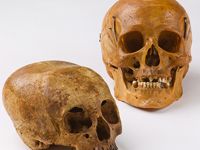From the archives
Posted: September 12, 2012
Two heads are better than one
A deformed skull (left) tells a story of mystery and intrigue. Its flattened and elongated shape was likely caused by frequently tying a board to the top of the head, a custom practiced by some cultures as a symbol of beauty or status. While its exact age and origin is unknown, the atypical skull offers unique insight to students. From a medical perspective, altering the shape of a skull could lead to headaches, eating disorders, and other health-related issues.
The typical skull (right) is used as a teaching tool at the University. It is estimated to be less than 100 years old and likely came from a donated cadaver.
Donor: Cranial Academy; Museum of Osteopathic MedicineSM, Kirksville, Mo. [1995.06.15]